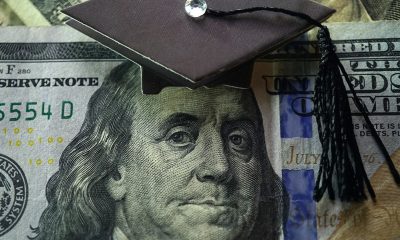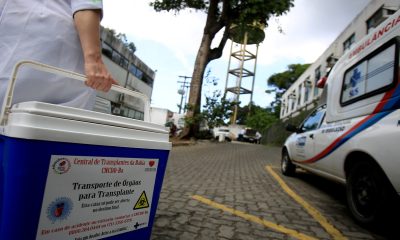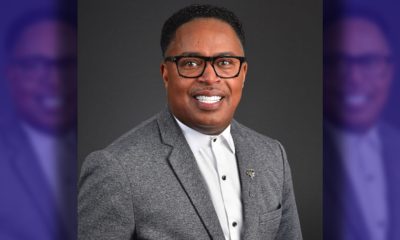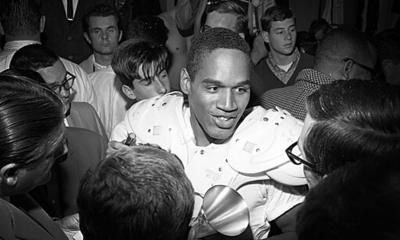Sports
Not Making the Grade: Why Big Time College Sports Continue Failing Black Male Student Athletes

by Starla Muhammad
Special to the NNPA from The Final Call
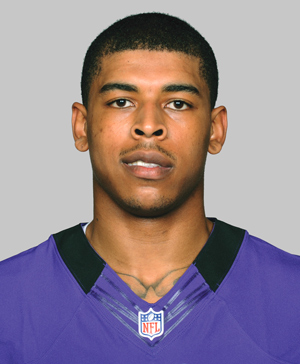
This 2012 file photo shows then-Baltimore Ravens NFL football player Michael McAdoo, who was released by the team in 2013. The former University of North Carolina football player has filed a lawsuit against the school, saying it failed to provide him and other athletes a quality education by guiding them toward sham classes.
|
A recent lawsuit filed by Michael McAdoo, a former football player at the University of North Carolina (UNC) accuses the institution of higher learning of failing to provide him with a quality education in exchange for his talents on the gridiron.
It is the latest fallout from an academic scandal that continues shedding new light on what critics argue is an old problem—the on-going exploitation of college athletes, particularly young Black male athletes.
The lawsuit, filed in U.S. District Court in Charlotte, stems from academic improprieties at UNC uncovered in a report revealing that nearly 3,000 students and student-athletes enrolled in so-called “no-show” classes in the Department of African and Afro-American Studies between 1989 and 2011. These independent study courses required students to write papers and there was little to no instructor-student interaction.
A 136-page report, “Investigation of Irregular Classes in the Department of African and Afro-American Studies at the University of North Carolina at Chapel Hill,” was released last month.
Student-athletes accounted for 47 percent of enrollment in the “no-show” or “paper” classes but make up only 4 percent of the school’s undergraduate student body, said the report. Of student-athletes enrolled in the classes, 50.9 percent were football players, 12.2 percent were men’s basketball players, 6.1 percent were women’s basketball players and 30 percent were Olympic and other sport athletes, the report continued.
“A good number of these student-athletes were ‘steered’ to the AFAM paper classes by certain academic counselors in ASPSA. This steering was most prevalent among the counselors for the revenue sports of football and men’s basketball,” noted the report. ASPSA stands for Academic Support Program for Student-Athletes.
The academic scandal that rocked UNC came to no surprise to Dr. Boyce Watkins an author and former finance professor.
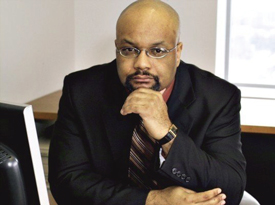 Dr. Boyce Watkins
|
“I’ve taught at four different universities with major athletics programs and at pretty much every school you see something ridiculous like this that occurs. Maybe not so broad and sustained and systemic as this but universities make it very clear that their number one priority is to make money, not to educate athletes,” said Dr. Watkins.
“What they do is they educate White kids with money earned by Black kids on the basketball court and the football field. It’s really a transfer of wealth due to the labor of what you might call indentured servants in a way but not quite the same thing of course,” he added.
While men’s college football and basketball means big bucks for universities, advertisers, athletic companies, boosters, stadiums and venues, the travel and tourism industry, restaurants and high paid coaches, players are more often than not left in the cold due to antiquated NCAA rules and regulations.
There are nearly 1,100 Division I, II and III colleges and universities that make up the NCAA. According to financial reports on ncaa.org in 2013, the NCAA raked in $912.8 million in total gross revenue which includes television and marketing rights fees, net investment income, championships and NIT tournaments, an increase from $871.6 million the previous year.
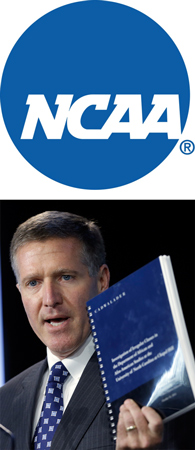
Kenneth Wainstein, lead investigator into academic irregularities at the University of North Carolina at Chapel Hill, holds a copy of his findings during a news conference following a special joint meeting of the University of North Carolina Board of Governors and the UNC-Chapel Hill Board of Trustees in Chapel Hill, N.C., Oct. 22.
|
But Mr. McAdoo was ruled ineligible to play by the NCAA in 2010 for allegedly receiving $110 in improper benefits in violation of rules. Part of the illegal benefits included an alleged prospective agent paying for an $89 hotel stay and $10 night club cover charge for Mr. McAdoo.
University of Georgia star running back Todd Gurley played Nov. 15 after serving a four game NCAA suspension for receiving money for signing autographs from memorabilia dealers.
In 2010 four football players from The Ohio State University were suspended by the NCAA for selling their own team memorabilia in exchange for a few thousand dollars and free tattoos.
According to the American Gaming Association, the FBI estimates over $2.5 billion is illegally wagered annually on March Madness and $80 million to $90 million legally wagered through legal gambling in Nevada. Last year the NCAA March Madness basketball tournament generated $1.15 billion in ad revenue. And the city of Atlanta, which hosted last year’s tournament, reportedly received a $70 million boost to its economy.
Players receive none of that money.
The “free” college education only applies to players who are able to stay academically eligible and if their scholarships are renewed annually. Players run the risk of being dropped from the team if they get injured and are unable to play.
Degree dilemmas and struggling to find a way
Of the Division I men’s basketball teams that were in the Sweet 16 tournament earlier this year, the graduation rate of White male student athletes was 98 percent, for Black male student athletes, it was an abysmal 55 percent according to The Institute for Diversity and Ethics in Sports (TIDES). The institute located at the University of Central Florida, is headed by Dr. Richard Lapchick.
The NCAA measures its Graduation Success Rates (GSR) on the percentage of players that graduate within six years of entering school.Among 70 college football teams heading to bowl games, during the 2013-14 season, the graduation rate for Black players was 65 percent versus 84 percent for White players. Nine out of 70 schools graduated less than half of their Black football players but none graduated less than half of White players.
On average, historically Black colleges and universities do not fare much better when it comes to graduating Black male student-athletes. Alabama State had a GSR of 81 percent in 2012-2013. Howard University was second at 61 percent. The average GSR of NCAA Division I HBCU football team that year was slightly over 47 percent. The University of Maryland Eastern Shore men’s basketball team led all HBCU’s in 2012-13 with a GSR of 86 percent.
Writer and professor Jessica Johnson of Central State University in Wilberforce, Ohio noted in a piece published on Online Athens that while Black colleges face problems with athletes graduating—far more pressure exists at White institutions.
“While there is pressure to win in the HBCU Division I conferences, it pales in comparison to what student-athletes face in major conferences like the Big Ten and Atlantic Coast Conference. Also, HBCUs rarely have players leaving early for the NBA draft, so that does not factor into their lower GSRs,” she said. Low GSR’s at HBCU’s need to be examined closely and concerns raised about potential hindrances to academic achievement so a stronger support system can be developed she added.
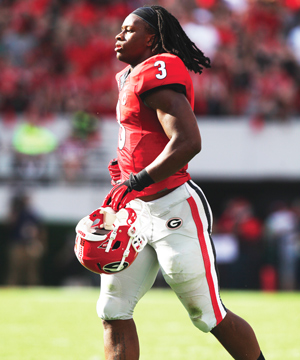
Georgia running back Todd Gurley (3) in action against South Carolina, Sept. 7, 2013 in Athens, GA.
|
College athletics is a business industry using unpaid labor and there are no incentives keeping the powerbrokers accountable to athletes providing the labor, explained Dr. Watkins.
“Coaches are not incentivized in their contracts to educate or graduate anybody. They get tiny bonuses for graduation almost just like honorariums. Their real bonuses come from winning championships,” said Dr. Watkins.
“If you are a coach and you’ve got a $5 million a year job on the line and your university has clearly stated in the contract that winning games is your number one priority; how much time are you really going to put into making sure these young men get educated? None.”
Dr. Lapchick said diversity in key decision making positions in colleges and universities could impact graduation outcomes.
“If you have all White men or overwhelmingly White men making the decisions in college sports you’re going to have a limited perspective on who to hire, on decisions to make and what’s important. It doesn’t augur well for college sports that the leadership positions in particular are overwhelmingly White,” he told The Final Call. Over 88 percent of presidents of Football Bowl Subdivision schools and conferences are White. Almost 85 percent of athletic directors and 100 percent of conference commissioners are White.
The continued educational gap between Black and White students in general is even bigger than it is on the collegiate athlete level, Dr. Lipchick pointed out. Therefore a Black student athlete in high school may end up being significantly farther behind than his White team mates. Unless schools are prepared and willing to help close that academic gap, Black athletes will continue to be at a serious disadvantage in completing their education, Dr. Lipchick added.
He has researched and studied issues in sports related to race and gender in collegiate and professional sports for over 50 years. Individual Black student athletes he has spoken to over the years told him they often feel college counselors put them in courses just to keep them eligible rather than helping athletes move toward completing a degree.
“There’s simply from (the counselors’) point of view no expectation. They’re valued clearly as basketball or football players or whatever their sport is but not so much as someone that might make a contribution in a political science class or economics class,” said Dr. Lapchick.
A change in direction?
Efforts to confront the NCAA and force changes are underway. Kain Colter, a former football player at Northwestern University, led efforts to have its players vote to form a union at the Illinois school after an official with the National Labor Relation Board ruled football players were employees and entitled to benefits such as workers compensation and a portion of revenue. The results of the April vote were impounded and will not be made public until the NLRB reviews the initial ruling. That is not expected to happen anytime soon.
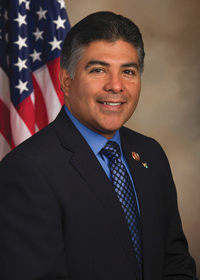
Rep Tony Cardenas (D-Calif)
|
Rep. Tony Cardenas (D-Calif.) introduced “HR 3545: The Collegiate Student-Athlete Protection Act” last November. Co-sponsored by Reps. Elijah Cummings (D-Md.), Charlie Rangel (D-N.Y.), Tim Ryan (D-Ohio), Jared Huffman (D-Calif.) and Betty McCollum (DFL-Min.) the act would ensure that an athlete’s inability to compete would not mean loss of athletic scholarships.
Among other benefits, the bill would require training in life skills and finance workshops, including explanation of the full rights provided in scholarships, concussion education and what student-athletes can expect to pay in health care costs. But a year later, there is still no movement on the bill, according to congress.gov.
It is also important that student athletes and their families understand what they are potentially getting into when accepting an athletic scholarship.
During a Nov. 14 interview on ESPN, University of Notre Dame head football coach Brian Kelly was asked what was the biggest difference he has seen over the last few years is in what recruits are looking for in a collegiate program. Recruits are concerned about getting a shot at making it to the NFL but they are also concerned about their education and life after football, he said.
“I really think the pendulum has swung back. Kids are thinking about their degree. They’re thinking about ‘how can I best have an opportunity when football is over,’ ” said Coach Kelly.
“They know and they read the stories in the NFL and how after their careers are over that they’re struggling maybe to make a career of it. So kids are thinking about the degree and success after. And I know that’s hard to do when you’re 17 but they have mentors, they have family members, they have others that are helping them and I think the pendulum has swung back over probably the last 5 or 6 years where kids are really considering that degree now,” said Mr. Kelly.
And while Notre Dame is number one in percentage of football players that graduate with degrees, it went through its own controversy earlier this year when five players, all Black, were dismissed from the squad for academic fraud. This came one year after current starting quarterback Everett Golson was suspended during the 2013 season for cheating on a test. An investigation revealed players had submitted assignments that were written or completed by others.
Eric Muhammad played two years of football at Arizona State University in 1993-94 after transferring from Pasadena City College in California. One of the biggest challenges many Black male athletes face is college is often a completely different culture and environment than they are used to. Also, if academics and school is not stressed in the home of an athlete, when they get to college they may struggle, he said. Universities need to have training programs and tools in place to help with this academic and environmental transition, said Mr. Muhammad.
He also agrees that college athletes should be paid for playing and have a right to be compensated in a fair and equitable way.
“If I can’t have my money right now, there needs to be something put aside because if 10,000 people are in the stands wearing my jersey I need to be compensated for that. The NCAA, in my humble opinion, is a complete racket and they’re raking in hundreds of millions of dollars in endorsement money from these companies and the athletes don’t see a portion. After I cashed my scholarship check, I had $80 left for the entire month. It’s insane,” he said.
Earlier this year a federal judge ruled to remove restrictions on money college athletes can get for use of their likeness, image and name but the NCAA can still cap the payments as long as the amount is not less than $5,000 a year for each year they compete.
The Honorable Elijah Muhammad of the Nation of Islam pointed out in his 1965 book “Message to the Black Man” that America more than any other country offers Black people opportunities to engage in sport and play, much to their detriment. The world of sports is causing tremendous amounts of evil and hundreds of millions of dollars change hands for the benefit of a few while hurting millions of poor people, wrote the Nation of Islam patriarch. His top student, Minister Louis Farrakhan, has repeatedly pointed out how historically, Black athletes have been used and exploited for their skills.
The reasons universities, the NCAA and others are allowed to continue to get away with what is happening is because the majority who are exploited are Blacks. Coaches and athletic departments control the academic futures of Black athletes but with that power should also come the responsibility to ensure they receive a proper education, Dr. Watkins pointed out.
“The only system in America that’s worse than the prison industrial complex is the NCAA,” said Dr. Watkins.



